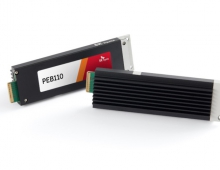
SK hynix’s Black Pearl 1.0um and 0.8um Image Sensors Launching This Year
SK hynix has strengthened the product competitiveness of its CMOS Image Sensor (CIS) business and has expanded its portfolio with new product line-ups with 1.0μm (micrometer) “Black Pearl” technology, set for laumch this quarter.
Ho-young Cho, Technical Leader (TL) at CIS Marketing Strategy of SK hynix said, “SK hynix officially names all of its CIS products as “Black Pearl” starting from this year, and plans to continuously introduce products that can deliver the best value to customers in not only the memory semiconductor market, but also the CIS market. We will do our best to establish a position in the CIS market that matches the brand’s meaning, like a black pearl considered as the rarest and the most beautiful pearl among all.”
Starting with 1.0μm Black Pearl line-ups in the first quarter, SK hynix plans to introduce a 0.8μm 48 MP product in the second half of the year.
Demand for image sensors for mobile devices is increasing rapidly. As telephoto cameras, which were mainly used for flagship products, are now being actively adopted in low- and medium-priced smartphones, demand for related image sensors is also expected to skyrocket.
As the total number of cameras increased, the rear cameras were subdivided into wide-angle, ultra-wide-angle, telephoto, depth, and macro cameras. Accordingly, the image sensor is also evolving in a direction appropriate for each camera’s characteristics. The image sensor for the main wide-angle camera which requires versatility is increasing the size of a pixel or securing the highest pixel density possible. For a telephoto camera that zooms in on a subject, image sensors are evolving to obtain a high magnification with small pixels. For ultra-wide-angle cameras which have a much wider field of view (FOV) than general cameras, image sensors are evolving in the direction of securing image quality by maximizing the revolution.
As the design where the area occupied by the camera hole in the front display is minimized and the entire front is covered by the display becomes common, a higher level of image quality is required for the front cameras. While the front cameras are getting smaller, consumer expectations for the shooting quality are continuously increasing. Therefore, the key competitive advantage now is how to achieve higher resolutions with smaller modules than competing products.
SK hynix’s four new 1.0μm Black Pearl CIS line-ups, which will be presented by SK hynix in the first quarter of this year, are the result of efforts to respond to such market changes. The company plans to actively target the changing smartphone camera market with the four new products ranging from 8 megapixels (MP) to 20 MP.

SK hynix reduced the pixel size from 1.12μm in the previous products to 1.0μm for the newly launched four 1.0μm Black Pearl CIS products, in order to respond to the resolution competition with the smaller module size. They feature Quad Pixel function to resize the pixel areas, as well as the Quad to Bayer (Q2B) Re-mosaic algorithm which, according to SK hynix, is more efficient compared to the one adopted in competing products.
"With these features, the new Black Pearl products not only are compatible with various types of cameras, but also boast excellent shooting quality in low-light environments," the S. Korean chip maker claims.
Among the new line-ups, Hi-1634 (16 MP) and Hi-2021 (20 MP) are products optimized for ultra-wide-angle cameras among smartphone rear cameras. In January, SK hynix started mass-production of these products. Ultra-wide-angle cameras require more pixels than basic cameras, because the spatial resolution decreases when the FOV increases. With the smaller pixel size, Hi-1634 and Hi-2021 are capable of fitting more pixels in the same space. In addition, by realizing the best performance that can be achieved with a pixel size of 1.0μm, these products have secured a high image quality that can be adopted even in the flagship smartphones.
In addition, Hi-1634 and Hi-2021 products’ Quad Pixel function allows them to respond to diverse shooting environments. They also possess various advantages including high resolution, low-light adaptability, and size competitiveness, making them useful not only in ultra-wide-angle cameras but also in front cameras.
The Hi-847 (8 MP) and Hi-1337 (13 MP) products are optimized for telephoto cameras among smartphone rear cameras. SK hynix began mass producing Hi-847 in last February, and the mass production of Hi-1337 is expected to begin in March.
The Hi-847 is an image sensor that supports 3x zoom despite a low module height. In the general module design, only 1.0μm 8 MP products are capable of 3x zoom, and only two companies including SK hynix provide such product in the current market. In addition, Hi-847 SK hynix says that the boasts higher cost-effectiveness compared to its competitors.
Th eHi-1337 supports 2x zoom, and it can be used in more various camera types as it has more pixels than Hi-847. Besides being applied to the rear telephoto camera, it can also be installed in a wide-angle camera, or a front camera that requires a low module height, making the application more diverse.





















